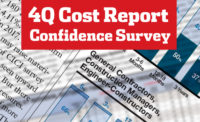The first six months of 2021 have seen big materials cost hikes, increasing labor shortages and uncertainty over federal action on a major infrastructure package. Despite the headwinds, ENR’s Construction Industry Confidence Index has surged up 17 points to a rating of 68—the highest single jump between quarters since the index was started in 2009. The previous record was 16 points between Q4 of 2011 and Q1 of 2012.
The index measures executive sentiment about where the current market will be in the next three to six months and over a 12- to 18-month period. A rating above 50 shows a growing market. The measure is based on 207 responses from industry execs to surveys sent between May 14 and June 21 to U.S. companies on ENR lists of leading general contractors, subcontractors and design firms.
The Index rose across all markets that ENR tracks, with the exception of power, which stayed flat. Confidence more than doubled in the entertainment sector and nearly doubled in both retail and hotels and hospitality. Optimism in the overall U.S. economy is even stronger, coming in at a 70 rating, the highest since the second quarter of 2018.
Related link: ENR 2021 2Q Cost Report PDF
(Subscription Required)
CFOs See a Strong Market
A similar jump in confidence can be seen in the results of the latest Confindex survey from the Princeton, N.J.-based Construction Financial Management Association (CFMA). Each quarter, it polls 200 CFOs from general and civil contractors and subcontractors about markets and business conditions. The Confindex is based on four separate financial and market components, each rated on a scale of 1 to 200. A rating of 100 indicates a stable market; higher ratings indicate market growth. The Confindex rose to a 115 rating, up 9.5% from 105 in the first quarter.

Both the “business conditions” and “current conditions” indices rose 16.3%, to ratings of 121 and 114 respectively. The “financial conditions” index rose 3.8%, to 110. The smallest bump was in the “year ahead outlook” index, which climbed only 1.8%, to 116.
“If you look at a year ago, June 2020, [there] are really remarkable differences,” says Stuart Binstock, CFMA’s CEO. He notes the 70.8% increase in the “business conditions” index since Q2 of last year as an example.
“What’s most remarkable is the strength of the demand for construction services coming out of this pandemic,” says Anirban Basu, CEO of economic consultant Sage Policy Group, Baltimore, and a CFMA adviser. The recovery of the construction industry seems to be right in line with that of the overall U.S. economy, instead of a few steps behind, he says. More executives indicated on the Confindex survey that their backlog has increased from a year ago than those who indicated a drop, Basu adds.
The economist attributes at least some industry resilience to changes pre-pandemic. “We saw a lot of consolidation in the industry, a lot of mergers, acquisitions, creation of scale [and] a lot of vertical integration with architectural firms, trying to internalize costs,” he says. That set firms up to deal neatly with cost concerns, lowered their overhead and made them more efficient. “And now with some segments of the economy really heating up, [those firms] are in pretty good shape from an operational standpoint.”
Efficiencies sought during the pandemic continue even as the pandemic winds down in the United States. “There used to be large pockets of [the industry] not being able to rationalize why they should invest in technology,” says Binstock. There is no question about the need to embrace new technologies now, he believes.
The industry’s chronic labor shortage may have been exacerbated by the pandemic. About 57% of respondents to ENR’s CICI survey indicated that staff shortages are worse than last year, with less than 9% saying that the gaps have eased. Most in demand are project managers, singled out by 29% of survey respondents.
But Basu sees longer-term changes by industry firms that are helping them to weather the storm. “Over the past decade [firms] have made changes in standard operating procedure and changes in organizational structure that have positioned them well for this period,” he says. The end result of all the efficiencies has meant that margins have often stayed strong.
The booming housing market is another cause for optimism. Basu suggests that more young Americans “are moving into their thirties, and often that coincides with a move to the suburbs.” The movement away from cities has been pushed along by the pandemic. “Ask yourself why Manhattan is so expensive. Proximity,” opines Basu, specifically to good jobs, entertainment and amenities. “But in a world of remote work, online shopping and streaming, proximity is not as valuable,” he says.
Retail space vacated in the wake of bankruptcies by big box retailers has pushed that trend as investors look to monetize that real estate. Basu expects an acceleration of investment in the suburban market. “Developers chase high valuations, and the rising valuations are in the suburbs,” he says.






Post a comment to this article
Report Abusive Comment